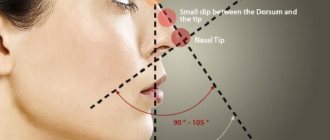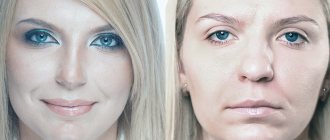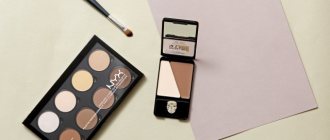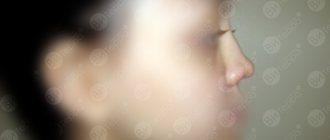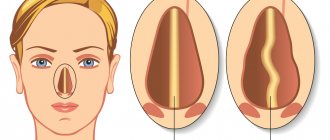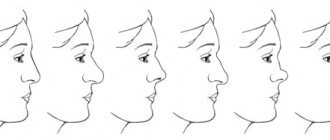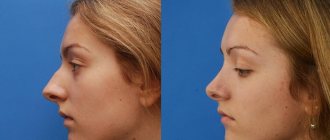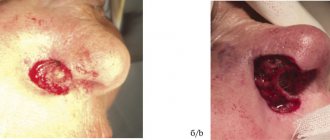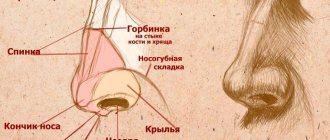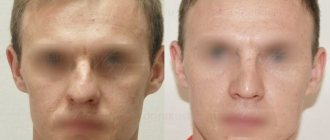According to Nika, the sculpting technique, the meaning of which is to lighten and darken certain areas on the face, will help to correct the nose. To “sculpt” the desired shape, you will need dark and light shades of cream or powder texture. By the way, cream products will last much better and longer.
To make your makeup look as natural as possible, it is important to blend the edges of your beauty products well. Adding natural shadows and highlights will also help to avoid the mask effect. A highlighter will do the job perfectly.
Crooked nose: causes of curvature and methods of correction
The cause of curvature of the nasal bones may be congenital defects in the formation of the face. Fetal anomalies occur in the first trimester of pregnancy. Associated with poor nutrition of the expectant mother, injuries, alcohol consumption, smoking, and past infectious diseases. The child receives a birth injury while moving through the pelvic tract of the woman in labor. In adolescence, there is a discrepancy between the growth rate of the nasal skeleton and surrounding tissues: with accelerated growth, the processes of the upper jaw, bones and cartilage are forced to deviate to the side.
Acquired pathology most often occurs due to injury. Sports injuries play a significant role.
Boxers are not necessarily patients of cosmetologists and surgeons; most do not even remember when they were injured. A crooked nose is complemented by a violation of the structure and curvature of the nasal septum, flattening of the back or the formation of a bone growth in the form of a hump (“bump”). In children, changes are possible due to vitamin D and calcium deficiency caused by rickets.
Facial tumors cause asymmetry; the nose can be straightened only after removing excess tissue. In adult patients suffering from hypertrophic rhinitis for a long time or with an unremoved foreign body, compensatory uneven tissue growth is possible.
Previous operations to correct the shape of the nose do not always end successfully. During rhinoplasty, not only the actions of the surgeon are important, but also the ability of the tissue to recover. If the conditions of rehabilitation are violated, the body does not have a sufficient supply of useful elements, then the result affects the anatomy of the nose. Possible uneven growth of callus and cartilage deformation.
Options for nasal deformity
Among the variants of curvature, surgeons distinguish external and internal signs.
External manifestations are visible visually. The patient has:
- asymmetry of the structure of the nose (size and shape of the nostrils);
- curvature of the back and tip of the nose;
- improper development of the wings, causing a violation of the proportions of the face.
Examination of the internal structures of the nose reveals:
- horizontal and vertical changes in the septum;
- the presence of “ridges” and “spikes”;
- C-shaped and S-shaped deformation.
Based on localization, disturbances are distinguished in the anterior and posterior zones, and according to the massiveness of the destruction of structures - partial and complete. All together in everyday language it is expressed by the term “crooked nose”.
"Potatoes"
The play of shadow and light can change the shape of the nose:
- Draw a clear line along the center of the back using highlighter.
- From eye level to the wings, draw two straight stripes on the sides of the previous line using a dark corrector.
- Darken the sides of the back and wings with a suitable powder.
- We shade everything.
Crooked nose: ways to correct the defect
There are limited indications for correcting the defect using conservative methods. Experts believe that results can be achieved if no more than three weeks have passed since the injury. Surgery is more often used. With the non-surgical method, it is not possible to simultaneously solve aesthetic problems and restore nasal function. Conservative methods include:
- plastic surgery with fillers with hyaluronic acid - injections of concentrated fillers in some cases can eliminate external asymmetry, mask tissue deficiency by adding to areas of volume deficiency;
- laser septochondrocorrection - the method boils down to softening the anterior sections of the septum, followed by manual correction of the shape;
- manual reduction with application of a plaster cast;
- use of elevator clothespins;
- massage.
Surgical interventions consist of rhinoplasty, which permanently removes defects in the wings and dorsum of the nose, resulting in the elimination of both aesthetic and medical problems of the patient.
How is crooked nose rhinoplasty performed?
The operation is performed under general anesthesia using closed (endonasal) or open (cutaneous) access. The advantage of the closed method is the maximum preservation of the thin septum between the nostrils, where the vessels pass. Endonasal surgical tactics help prevent the formation of scar tissue and scars on the face, and shorten the recovery period. Indicated for asymmetry caused by impaired development of facial tissues.
Percutaneous access requires incisions inside the nasal passages and in the folds of the skin. But for the surgeon it is more informative, it makes it possible to examine deep-lying tissues, place large or medium-sized grafts, and achieve complete elimination of the defect. Used after injuries, repeated operations. The surgeon freely manipulates the area of the nasal turbinates and septum. Grafts to increase bone tissue are taken from the patient himself (ribs, hips) or use synthetic materials.
After opening the septum, the doctor excises the scars and removes overgrown areas of bone tissue with a chisel. At the end of the operation, the nasal passages are tightly packed so that the septum is in the median position.
Surgical correction of nasal deformity
The operation to correct the shape of the nose surgically lasts 1 hour. There is a distinction between primary rhinoplasty and secondary rhinoplasty, when it is necessary to eliminate problems that arose after the first intervention. If nasal breathing is impaired, septoplasty (correction of the shape of the nasal septum) is often performed. During the operation, the doctor can not only straighten the nose, eliminating the curvature, but also perform cosmetic interventions: change the width of the back, remove the hump, reduce the length due to the tip.
Laser nasal septum straightening
A modern non-surgical (minimally invasive) method of straightening the nasal septum is called laser septochondrocorrection. The essence of the technique: a laser beam is used to specifically heat the anterior section of the septum to soften the cartilage tissue. The surgeon then manually reshapes and inserts a thick tampon with a plaster cast. Disadvantages of this method:
- the laser affects only the anterior part of the septum;
- changes are made due to cartilage;
- it is possible to obtain a result only with asymmetry of the nostrils; if the curvature is caused by bone tissue, then the method is not applicable;
- use is limited by the high cost of surgery;
- the long-term effect has not been sufficiently studied.
Nasal septum removal
Removal or “submucosal resection” of part of the nasal septum is performed if the tissue growth and shape do not allow for complete opening of the nasal passages. The operation consists of cutting off the overgrown parts. It is possible to install an implant. Surgeries to completely remove the nasal septum are not performed.
What does endoscopic septal realignment mean?
A deviated nasal septum is quite common, but requires intervention only when breathing changes. A modern minimally invasive technique allows using an endoscope to identify the area of deviated septum without incisions. If it is associated with the growth of bone tissue in the form of “ridges” or “spikes”, then the excess tissue is removed. This cauterizes the blood vessels to prevent bleeding. The method is safe and used on an outpatient basis. The rehabilitation period is much shorter than with elective surgery.
Fixing the Roman profile
This type of nose is characterized by a distinctly arched bridge and a slanted tip. If men are proud of their natural hump, then most of the fair sex try to hide it.
We correct the hump by darkening it with mattifying powder. The rest of the back needs to be lightened. At the same time, we pay special attention to shading: if this is not done carefully, then the darkening will appear as a dirty spot. Blend with a soft, clean brush.
If you want to emphasize your hump, brush it with a puff of light powder.
Crooked nose: rhinoplasty or non-surgical correction?
The problem of how to correct a crooked nose using the optimal technique is solved jointly by otolaryngologists and doctors from the departments of maxillofacial surgery. The pros and cons of various methods are taken into account. The table shows the main arguments for the planned treatment.
| Non-surgical correction | Method name | Advantages | Flaws |
| Contour plastic with fillers with hyaluronic acid | no preparation needed performed on an outpatient basis in 1 hour recovery occurs quickly | corrections concern minimal asymmetry does not solve functional problems; the result lasts up to 12 months, then the injections must be repeated filler migration is likely; after repeated administration, tissue structure is disrupted | |
| Rhinoplasty with absorbable drugs | the drug is injected only into a convex surface that makes breathing difficult performed on an outpatient basis the result comes after 2 weeks | an accurate calculation of the need for the drug is necessary acts on soft tissues, not bone structures carried out in stages requires caution due to possible allergies | |
| Rhinoplasty with Aptos threads | eliminates asymmetry of the tip of the nose, wings | high risk of scarring and rupture of threads | |
| Operation | Rhinoplasty open and closed method | lifelong result completely restores breathing through the nasal passages compatibility with the elimination of cosmetic defects | the rehabilitation period lasts six months ; the need for inpatient treatment |
Indications and contraindications for surgery
When the nose is bent, patients suffer from physiological disorders. The operation is indicated in the following cases:
- persistent nasal congestion interferes with breathing, but is not associated with allergic rhinitis;
- often suffers from runny nose and sneezing;
- bleeding from the nasal passages is observed;
- loss of smell due to atrophy and swelling of the olfactory nerve;
- the pathology causes inflammation of the nasal sinuses, chronic otitis media, headaches, and disability.
Proper nasal breathing ensures sufficient saturation of the brain blood with oxygen. A runny nose is accompanied by brain hypoxia and spastic contraction of blood vessels. The person becomes drowsy, lethargic, and loses ability to work. Replacing breathing with your mouth does not allow you to warm the cold air and eliminates the retention of bacteria and viruses. Therefore, patients often experience laryngitis and are prone to respiratory infections.
In ENT departments, beds are necessarily allocated for young men who want to enter military schools after school. Obstruction of the nasal passage is especially dangerous for future sailors, submariners, pilots, navigators, and all specialists working at altitude in space. The communication of the nasal passages with the external environment helps maintain pressure on the eardrum. Nasal congestion causes otitis media, severe pain, hearing loss, and bleeding from the ears.
A person with an internal nasal deformity typically snores during sleep. Somnologists have established a connection with sudden cessation of breathing.
Contraindications are general for any surgery:
- blood clotting disorder;
- age up to 18 years (although in case of severe breathing problems, the child is operated on after 7 years);
- pregnancy;
- chronic diseases in the decompensation phase;
- mental changes.
Some patients talk about one half of the nose. Such compensatory hyperfunction after a few years will lead to atrophy of the epithelial covering of the nasal passages.
Temporary contraindications are:
- signs of an acute infectious disease - it is necessary to wait up to three weeks after recovery before surgery;
- women are recommended to have surgery in the middle of the menstrual cycle;
- taking anticoagulant medications should be stopped 2 weeks before the expected date of the intervention.
How to avoid complications after surgery
After rhinoplasty and septoplasty, the following complications are possible:
- infection in the wound, inflammation;
- bleeding from the vessels of the nose;
- formation of scars, adhesions;
- formation of hematoma in the nasal cavities;
- perforation of the septum.
To reduce the risk of complications, surgeons must strictly consider contraindications for surgery. Patients should follow the specialist's recommendations. Doctors require:
- When inserting tampons and applying a plaster cast, observe the installation times and do not remove them prematurely;
- if the wound is bleeding, use tampons with hydrogen peroxide;
- to prevent infection, conduct a course of antibiotic therapy;
- stop playing strenuous sports for the next six months;
- do not take a steam bath, refuse hot baths;
- beware of respiratory viral infection and runny nose;
- sleep only on your back;
- do not wear glasses unless necessary to avoid pressure on the bridge of the nose.
Makeup products that will help visually reduce your nose
Visual correction of insufficiently correct contours of the nose is achieved by using the following makeup products:
- Mattifying face cream, depending on skin type.
- Foundations with the required color range.
- Compact powders of two or three varieties, including matting ones.
- A taupe corrector that best suits your skin and hair color.
- Beveled flat and fluffy brushes.
- Mattifying, absorbent wipes that allow makeup to be adjusted over time.
It is important to choose the right brushes for applying cosmetics so that they are applied with the required precision.
A prerequisite is the absence of flickering particles in the products, since this neutralizes the achieved effect. Also, the desired result should look natural in the transitions of light and shadow.
